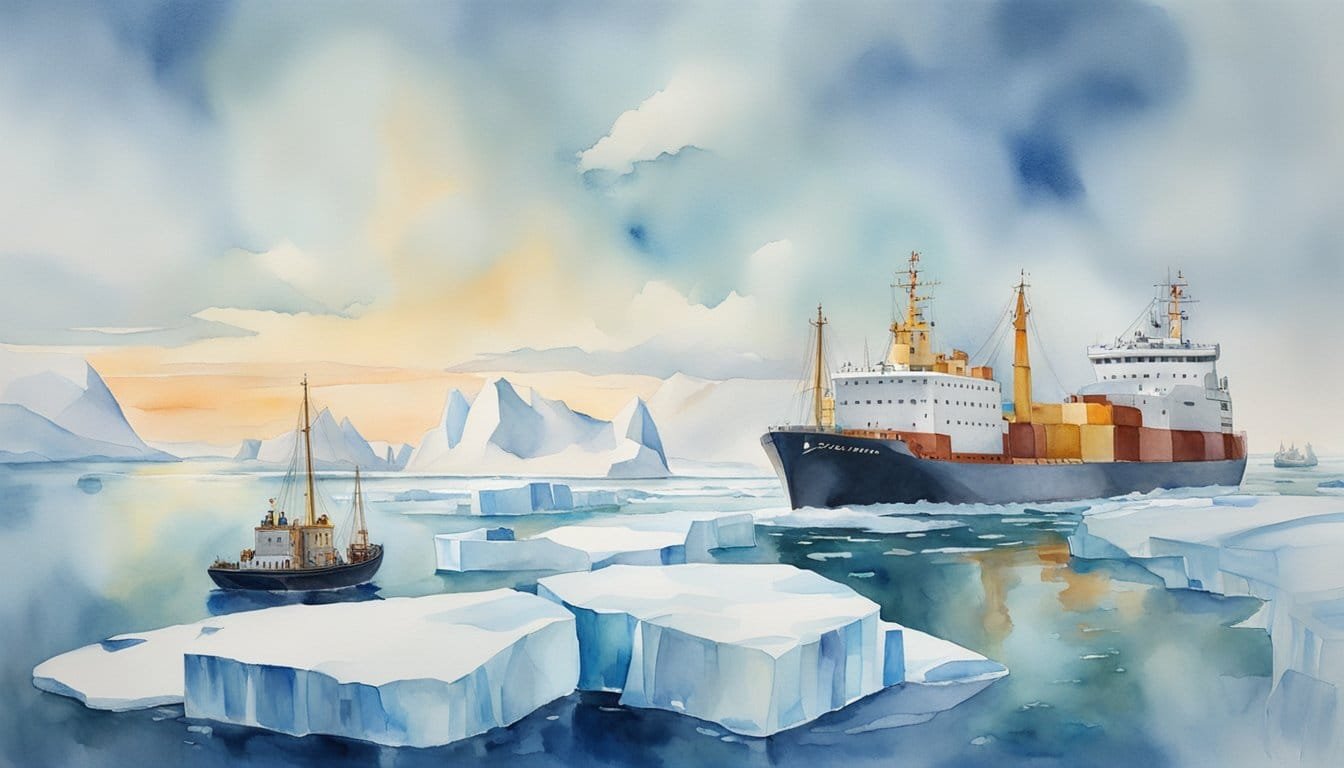Geopolitical Dynamics in the Arctic
The chessboard of the Arctic is getting intense with each move from global players like China and Russia reshaping the region’s landscape. From cooperative endeavors to strategic military positioning and the reverberating echoes of global conflicts, each aspect intricately influences the North’s future.
Sino-Russian Cooperation and Intentions
China’s ambitions in the Arctic, such as the Polar Silk Road, signal its intention to secure a strong footing in the region. Russia, eyeing economic and strategic advantage, joins forces with China to navigate the treacherous terrain of Arctic politics. Together, they’re determined to develop the Northern Sea Route, which promises to reshape global trade dynamics. Their partnership is scrutinized for aims beyond economic benefits, hinting at a shared strategy to offset Western influence, especially from powers like the U.S. and the EU.
Arctic Council and International Response
With the Arctic Council at its helm, the region has witnessed a multifaceted international response. This high-level forum engages Arctic stakeholders including Russia, the U.S., and representatives from indigenous communities, but non-Arctic states like China seek observer status to gain political influence. Nordic countries like Sweden and Finland weigh in, balancing their interests with environmental concerns and pressures from NATO allies. The inclusion of diverse voices echoes a commitment to manage Arctic resources and address emergent challenges through diplomacy rather than conflict.
Military Strategies and Defense
The chill of the Arctic is matched by the cool calculations of military strategists in Moscow and Washington. Russia has reaffirmed its military presence, upgrading bases and deploying advanced weapon systems in the East Siberian Sea and along the Bering Strait. Concerns arise from their foothold in the High North, pointing to a strategic architecture aimed at deterrence. Meanwhile, NATO allies and nations bordering the Baltic Sea brace for ripple effects, enhancing their own defense measures in the shadow of the Circumpolar North.
Impact of Ukrainian Crisis
The invasion of Ukraine by Russia has sent shockwaves that resonate even into the Arctic’s icy expanses. Sanctions imposed on Russia by the EU and allies have spotlighted the Kremlin’s isolation on the global stage. As a direct consequence, the Arctic becomes a focal point where power plays are subtle yet profound, hinting at a strategic tug-of-war on whether Western sanctions should be extended or relaxed in the face of global security and economic interests. This delicate balance plays out over the region’s vast resources and Arctic stakeholder positions, with all eyes on Vladimir Putin’s next move.
Economic and Environmental Considerations

The Russian-Chinese partnership in the Arctic intertwines economic ambitions with environmental realities, where the lure of untapped energy clashes with climate concerns and the evolving geopolitical landscape shapes new trade pathways.
Energy and Natural Resources Exploration
Russia and China have underscored their interests in the Arctic’s vast energy reserves. The collaboration between the two nations often centers on the extraction of oil and natural gas—a critical component for China’s energy security and Russia’s economic stability. Key players like Rosatom are pivotal in navigating the Barents Sea’s potential, where estimated reserves spark international attention for joint ventures and investments.
Infrastructure Developments and Challenges
The harsh Arctic environment imposes significant challenges to infrastructure development. Yet, the strategic importance of the region has driven Russia to bolster its Northern Fleet while China, as part of its Polar Silk Road initiative, seeks to partner in developing ports and other critical infrastructure. These advancements aim to support the burgeoning shipping routes as well as energy exploration activities.
Arctic Trade Routes and Global Economy
Revolutionizing global trade, the Northern Sea Route (NSR) offers a shorter transit from Asia to Europe, slicing through Russia’s Arctic coast. This route saves time and fuel compared to the traditional Suez Canal path, and as ice recedes due to climate change, it becomes more navigable, potentially reshaping global trade dynamics. The role of China here is twofold: as a major user of the NSR and as a partner in developing the route’s full economic potential.
Climate Change Implications
Lastly, the environmental footprint of increased Arctic activity is undeniable. China’s presence in the Arctic invites not only economic ambitions but also scientific research focused on understanding the climate change implications. As temperature rises and ice melts, the ecological balance and traditional ways of life in the Arctic face unprecedented threats, making international cooperation imperative in managing these environmental changes.

